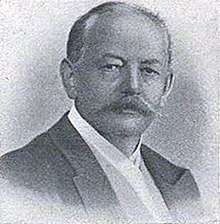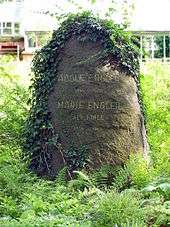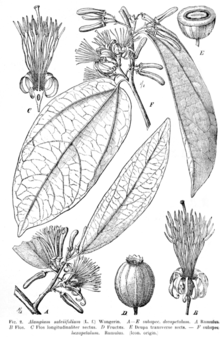Adolf Engler
Heinrich Gustav Adolf Engler (25 March 1844 – 10 October 1930) was a German botanist. He is notable for his work on plant taxonomy and phytogeography, such as Die natürlichen Pflanzenfamilien (The Natural Plant Families), edited with Karl A. E. von Prantl.
Adolf Engler | |
|---|---|
 | |
| Born | 25 March 1844 |
| Died | 10 October 1930 (aged 86) |
| Nationality | German |
| Alma mater | University of Breslau |
| Known for | Die Natürlichen Pflanzenfamilien |
| Awards | Linnean Medal (1913) |
| Scientific career | |
| Fields | Botany, plant taxonomy |
| Institutions | Botanical Institute of Munich University of Kiel University of Berlin |
Even now, his system of plant classification, the Engler system, is still used by many herbaria and is followed by writers of many manuals and floras. It is still the only system that treats all 'plants' (in the wider sense, algae to flowering plants) in such depth.[1]
Engler published a prodigious number of taxonomic works. He used various artists to illustrate his books, notably Joseph Pohl (1864–1939), an illustrator who had served an apprenticeship as a wood-engraver. Pohl's skill drew Engler's attention, starting a collaboration of some 40 years. Pohl produced more than 33 000 drawings in 6 000 plates for Die naturlichen Pflanzenfamilien. He also illustrated Das Pflanzenreich (1900–1953), Die Pflanzenwelt Afrikas (1908–1910), Monographien afrikanischer Pflanzenfamilien (1898–1904) and the journals Engler's botanische Jahrbücher.[2]
Biography

Adolf Engler was born on March 25, 1844, in Sagan, Silesia, now Żagań, in western Poland as Heinrich Gustav Adolf Engler, and died in Berlin, Germany, on October 10, 1930.
He studied and obtained a PhD from the University of Breslau (now Wrocław, Poland) in 1866. After some years of teaching, he became, in 1871, custodian of botanical collections of the Botanische Institute der Ludwig Maximilian University München (Botanical Institute of Munich), remaining there until 1878, when he accepted a professorship at the University of Kiel, where he stayed until 1884, teaching systematic botany. Also in 1878, Engler was elected into Leopoldina, German Academy of Natural History. He went back to Breslau in 1884, as director of the Botanical Garden, succeeding Goeppert, and appointed professor of botany at the University of Breslau. From 1889 to 1921, Engler was a professor at University of Berlin, and director of the Berlin-Dahlem Botanical Garden, transforming it into one of the greatest botanical gardens of the world.
He visited several regions of the world, enlarging the knowledge of floristic distribution, especially of Africa.
Works

plate from Das Pflanzenreich
Plant taxonomy
Besides his important work in general plant taxonomy, he was also an expert in some taxa, such as Saxifraga, Araceae, Burseraceae, and others.
Adolf Engler collaborated with several other great botanists, including Alphonse de Candolle on the Monographiae Phanerogamarum (Monographs of Flowering Plants), and C.F.P. von Martius on the monumental work Flora Brasiliensis (Flora of Brazil).
He founded the journal Botanische Jahrbücher für Systematik, Pflanzengeschichte und Pflanzengeographie (Botanical Yearbook for Systematics, Plant Phylogeny and Phytogeography, ISSN 0006-8152), published in Leipzig, Germany, which has continued in publication from 1881 to the present. In 2010, this publication changed its name to Plant Diversity and Evolution: Phylogeny, Biogeography, Structure and Function, ISSN 1869-6155.
- Die Natürlichen Pflanzenfamilien (The Natural Plant Families), edited with Karl A. E. Prantl, with the collaboration of many notable experts, 1887–1915, 23 volumes: This enormous series is one of the very few detailed works (since Linnaeus) to attempt the classification of plants from algae to flowering plants, and constitutes an invaluable work. A second, incomplete edition was produced (1924–1980) in 28 parts by Duncker und Humblot Verlag, Berlin).[1][3] Some volumes have been re-issued in English.[4] The second edition was hard to use for many years because no part of it was indexed until 1984, when an index was published in the Annals of the Missouri Botanical Garden.[5]
- Das Pflanzenreich (The Plant Kingdom), with the collaboration of many notable experts, 1900–1968: This monographic series on the plant kingdom is presently incomplete.[1][6]
- Syllabus der Pflanzenfamilien, 12th ed., edited by H. Melchior & E. Werdermann, with the collaboration of many notable experts, 1954–1964: This is the most recent summary of the Engler system and gives descriptions of the higher taxonomic levels, in two volumes.[1]
Phytogeography
He was one of the pioneers in this field of science, highlighting the importance of factors such as geology on biodiversity, and defined biogeographical regions in 1879.
- Vegetation der Erde (Vegetation of the Earth), 1896, with O. Drude
- Die Pflanzenwelt Ost-Afrikas und der Nachbargebiete (The Plant World of Eastern Africa and the Adjacent Regions), 1895 (available at Biodiversity Heritage Library)
Recognition
He received the Linnean Medal in 1913. The International Association for Plant Taxonomy established the Engler Medal in his honour in 1986, to be awarded for outstanding contributions to plant taxonomy.[7]
He was elected a foreign member of the Royal Netherlands Academy of Arts and Sciences in 1920.[8]
The journal Englera (ISSN 0170-4818) published by the Berlin-Dahlem Botanical Garden, Germany, is also named after him. Many genera (in various 'plant' groups) are named in his honour, such as Englerastrum, Englerella, Engleria, Englerina, Englerocharis, Englerodaphne, Englerodendron and Englerophytum.
Engler is commemorated in the specific epithet adolphi.[10]
See also
References
- Woodland, Dennis W. (1997). Contemporary Plant Systematics (2nd ed.). Andrews University Press. ISBN 1-883925-14-2.
- 10. about the illustrators and illustrations Archived July 4, 2008, at the Wayback Machine
- Die Natürlichen Pflanzenfamilien Duncker und Humblot Verlag
- Die Natürlichen Pflanzenfamilien 17a
- Morley 1984.
- Davis, M.T. (1957). "A guide and an analysis of Engler's "Das Pflanzenreich"". Taxon. 6 (6): 161–182. doi:10.2307/1217029. JSTOR 1217029.
- IAPT 2016.
- "H.G.A. Engler (1844 - 1930)". Royal Netherlands Academy of Arts and Sciences. Archived from the original on 29 July 2020.
- IPNI. Engl.
- Eggli, Urs; Newton, Leonard E. (2004). Etymological Dictionary of Succulent Plant Names. Berlin, Heidelberg: Springer. p. 3. ISBN 978-3-540-00489-9. Retrieved 5 October 2018.
Bibliography
Works by Engler
|
Works about Engler
Websites
|
External links
| Wikimedia Commons has media related to Adolf Engler. |
| Wikispecies has information related to Adolf Engler |
- Works by Adolf Engler at Biodiversity Heritage Library

- Works by Adolf Engler at Open Library

- Works by or about Adolf Engler at Internet Archive
- Adolf Engler. "Search for 'Engl.'". International Plant Names Index (IPNI). Royal Botanic Gardens, Kew. Retrieved March 25, 2008.